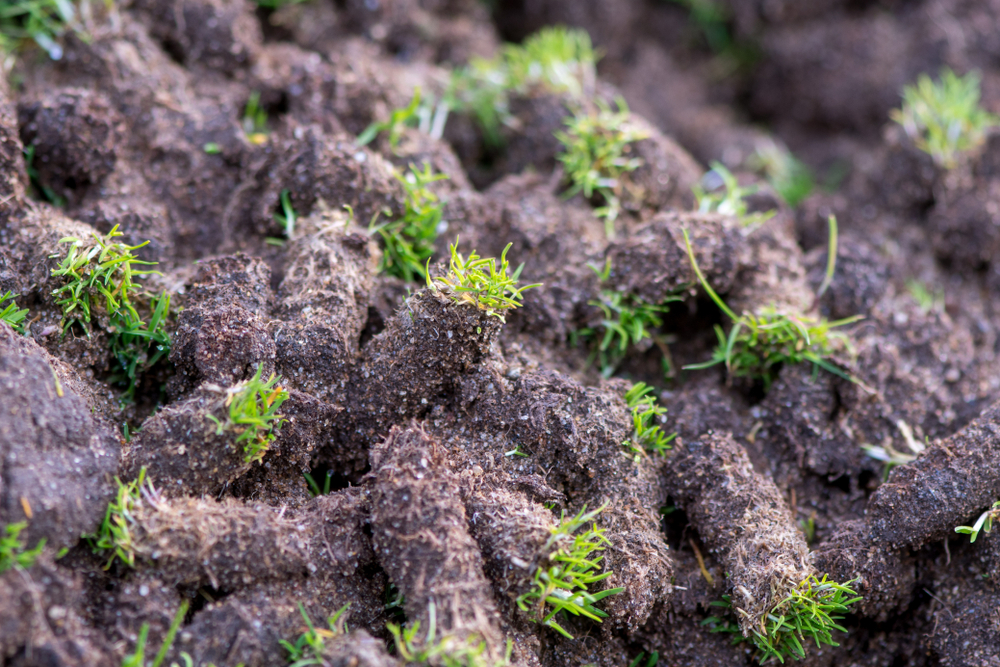Does your lawn have dead grass and bare spots? Patches of brown grass? Do you often have puddles forming while watering or after watering?
These are signs of compacted soil. If you have recently tried to dig with a shovel or hand tool and couldn’t get to the soil layer, that’s also a sign of compacted soil.
If your soil is thick with a lot of clay content, it will also compact more quickly than soil with more organic content.
So, what caused the compaction in the first place?
- Working with the soil when it’s too wet.
- Over-tilling soil. It breaks the soil into individual particles instead of tiny lumps of soil. Air and water cannot get between the particles.
- Compacted soil happens where there is a lot of foot traffic or moving heavy machinery. It happens near the sides of driveways, roads, and sidewalks.
- Soil also needs a certain amount of organic material to give it some volume, fluffing it up as you would fluff your hair.
- Lack of “pore space.”
- Mixing sand into the clay. It doesn’t loosen soil; it does just the opposite.
Loosening compacted soil can be accomplished in several ways:
- Aerating the soil can help.
- Adding organic materials to the soil can help loosen it.
- Compost and peat moss are good options to add to the soil.
- Earthworms and microbes. (Need I say more?)
- Giving it pore space or room for air and water to move around the mineral particles will help to improve the situation.
Aeration – How?
Aerating the soil can be accomplished by biological or mechanical means. All of the most successful ways will use some kind of spike to poke through the upper layers of the lawn and into the compacted soil.
You can purchase aeration shoes, which have spikes poking down. You will need to lift your feet up, step by step, till the spikes are clear of the grass, and then push your feet hard enough on the next step, till the spikes are extended into the compacted soil. It’s very labor-intensive, especially for your legs.
Power aerators come in many sizes, but when your Rish landscape partners come to aerate the lawn, they will probably use a machine about the size of a lawnmower.
Their first step is to locate and flag the irrigation system and all the pipes and hoses located underground. They will probably also give the lawn a heavy watering the day before the aeration process occurs.
The machine has spikes that rotate as the aerator moves across your lawn. These will remove minuscule plugs of the compacted soil, leaving tiny holes for water, air, and new seeds to flow through.
Earthworms?
Although these are mechanical means of aerating, there are also biological means. For example, adding earthworms or good bacteria to your lawn can keep it refreshed and growing.
Earthworms are decomposers of organic matter. They leave behind a tunnel or channel when they move through the soil. These can last a long time in your soil, helping to keep it aerated.
Earthworms tend to live in soil zones based on the depth of their environment.
- Earthworms that live in the surface area of the soil are usually small, eat decomposed plant material, and adapt well to soil and temperature changes.
- Earthworms that live near the upper soil also feed on organic matter and soil material. They form tunnels that will help keep the soil aerated.
- Deep burrowing earthworms can extend their tunnels several feet deep into the soil. They feed on surface residue, which they pull back into their burrows.
If you are a composter, you know what a great help earthworms can be in breaking down your organic waste. Having a large population of earthworms indicates soil health. As they move around, the tunnels create more air space.
However, using no-till methods is best for maintaining your earthworm population’s health. Chemical use will also need to be controlled if your earthworms are to flourish. Your landscape experts can further explain the benefits of a healthy earthworm community.
What’s next?
Your Rish experts will probably recommend overseeding after aeration.
Overseeding is spreading grass seed into the aerated grass areas without tearing up the turf or soil.
Before overseeding, your landscape partners may recommend a soil test to determine the soil type and pH. However, since they work in your area, they may not bother with a test since the soil is probably very like other local soil.
The seed will go into the holes created by the aeration and into the lawn and soil – and flow with the water applied before aeration. Then, the seed or turf-building combination of seed and fertilizer will be applied with a regular spreader.
Once the seed germinates, the new, stronger roots and stems will move through the aeration holes and start putting out new roots that will help break up the compacted soil.
Your lawn expert may choose a different kind of seed for overseeding. For example, it might be better adapted to your climate, geographic area, or soil chemistry. This will help make your lawn stronger, greener, and more diverse to survive any problems that might happen.
Fertilizer may be applied at the same time or right after overseeding. Your sprinkler system will probably be set to water every day for a short time in the morning. Afternoons and evenings have much more evaporation, so watering in the morning will ultimately save water.
How long till the grass grows?
Since Pennsylvania is one of our northern states, with extended cold weather and winter, cool-season grass seed will probably be used to overseed. Germination can happen in as little as ten days if applied at the right time of year (several months of cold temperatures ahead), and you should see the effect on your lawn within a month or so.
Will you be watching your grass grow?
 info@rishlawncare.com
info@rishlawncare.com
